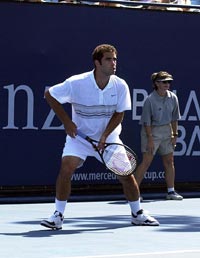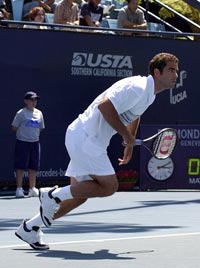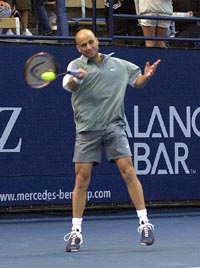The Aggressive Margin
By John Yandell
If a tennis player wants to gain a real understanding of his wins and loses in competitive match play, he needs to understand how he wins and loses points from a quantitative, or statistical perspective.
In the first article in this series, we explained the critical role of the forced error in understanding
match statistics. This article introduces another key statistic, the "Aggressive Margin."

Let's see what the Aggressive Margin is and what it tells us about the classic Sampras/Agassi confrontation at the 2001 U.S. Open. Then we'll compare that to the margin in some of their other classic match ups over the years. In a future article, we'll see how it illuminates who wins and loses at other levels of play.
The Aggressive Margin was first developed decades ago by the father of modern tennis statistics, Bill Jacobsen. It's a composite statistic that combines how a player wins and loses all points into a single index. Understanding this one key number allows any player to see exactly what happened in a given match, and how.
Basically all tennis points end in one of three ways: winners, unforced errors, or forced errors. The Aggressive Margin puts all three together into a comparative measure. This is one reason why it's so important to chart the forced errors-without them, it's impossible to measure the Aggressive Margin.
So how do we calculate the Aggressive Margin? First for a given player, we add up the total points won through winners and the total points won through forced errors. Then we subtract the total number of unforced errors. The difference is the margin of points the player won by aggressive play. This is "The Aggressive Margin."
The Aggressive Margin can be calculated for an entire match, and also on a set by set basis. We can also break down the Aggressive Margin by individual stroke. In each case it can be a positive or a negative number.

Here is a hypothetical example of how the Aggressive Margin works. Let's say in a given set a player hits 10 winners, forces another 10 errors, and has 10 unforced errors. Combining the winners and forced errors we see that the player generated 20 points through his aggressive shot making. If we then subtract his unforced errors, we get his Aggressive Margin for the set. In this case, 20 points won forcing, less 10 unforced errors, equals an aggressive margin of +10/set (20-10 = +10).
In another example: let's say the same player generates 10 winners and forced errors, but makes 20 unforced errors. Then his aggressive margin is a negative number: -10/set (10-20 = -10).
The Aggressive Margin explains how particular players win particular matches against particular opponents. It lets us compare the level of play of one player to another. It also allows us to see an individual player's consistency over a series of matches.
Unfortunately the Aggressive Margin was never widely adopted by tournament or television statistics. That's too bad because the Aggressive Margin gives an instant overview about how matches are won. At the same time it is extremely easy to understand.
Are you really winning the matches you play, or are you simply relying on your opponent to lose them? A positive Aggressive Margin means you are winning more points than you are losing through your own shot making. If both players have a positive Aggressive Margin, then in virtually all cases, the player with the higher positive Aggressive Margin wins the set. (The first set in the Sampras/Agassi quarterfinal was one of the rare exceptions, as we shall see.)
If your Aggressive Margin is negative, on the other hand, it means you are losing more points than you are winning. This means you can only win by relying on your opponent to make more errors than you. Your opponent's Aggressive Margin must be a higher negative number than yours.
Whereas most pro matches are decided by one player compiling a higher positive Aggressive Margin, matches at lower levels are often the opposite. Both players will frequently have negative Aggressive Margins. Neither player really "wins" the match, it's just that the player with the higher negative number loses.


I once charted a girls' high school match for a player I was coaching. She was thrilled to win in straight sets and thought she had played well. The numbers, however, showed that her Aggressive Margin was actually -9/set. In reality it wasn't that she had won through her positive play, only that the other girl had played much worse. Her opponent's Aggressive Margin was almost double hers at an amazing -17/set! That's the equivalent of just giving away more than 4 games in a single set.
Many players struggle to understand why they defeat some opponents, then play exactly the same way against other players and lose badly. The Aggressive Margin tells the tale. My high school player could have played just as "well" against a player who generated positive numbers and have lost as easily as she won the match with the player who was more negative than she.
The Aggressive Margin by Stroke
The Aggressive Margin can also be broken down by individual stroke. This allows us to understand exactly why a certain player's overall margin is "positive" or "negative" in a given match, pinpointing the sources of winners and errors.
Sometimes a player can be consistently negative on one stroke, and find that it is the difference in a large numbers of his matches.
For example, a player might have a positive Aggressive Margin on his forehand, but a negative Aggressive Margin on his backhand. He could be +5/set for his forehand, but -10/set on his backhand and still negative for the match at -5/set. Eliminating half of his unforced backhand errors might completely reverse the outcome of a given match.
The bottom line though is any player at any level is as only as good as his overall Aggressive Margin, relative to his opponents. And in general, the higher the overall Aggressive Margin, the higher the level of play. For example, the Agassi/Sampras match at this year's Open was off the charts, with the highest Aggressive Margin numbers of any match I've ever charted.
Let's compare the numbers for these two players and see what they tell us about that historic match. Let's start with the overall Aggressive Margin, and then the Aggressive Margin set by set. After that we can examine the individual strokes and see how they figured into the whole.
As we saw in the first article, the match was extremely close, not only so far as the score went (4 tiebreakers is about as close as it gets), but statistically in terms of the total number of points won by each player.
Pete won a total of 173 points to 161 for Agassi. That's 12 more points won by Pete over the course of 48 games and 4 tiebreakers. If we count the breakers as the equivalent of 2 games, that means over every 4 to 5 games Pete won one more point than Andre. It's a very small edge, but it turned out to be enough to swing the match.
U.S. Open 2001 |
Pete |
Andre |
| Total Points Won | 173 |
161 |
Let's see how those points break down. Pete hit 79 winners and generated another 74 forced errors. That was an incredible 153 points won by forcing shots. Over 4 sets, he also made 56 unforced errors. Subtracting this from the points won forcing we get an overall Aggressive Margin of +97. That equals an Aggressive Margin of +24.25/set.
Now let's compare that to Agassi. Andre hit 47 clean winners and forced another 58 errors. That was 105 total points won forcing. Over 4 sets he made only 20 unforced errors, for a total Aggressive Margin of +85. That's an Aggressive Margin of +21.25/set.
Aggressive Margin U.S. Open 2001 |
Pete |
Andre
|
| Winners | 79 |
47 |
| Forced Errors | 74 |
58 |
| Total Points Won Forcing | 153 |
105 |
| Unforced Errors | 56 |
20 |
| Total Aggressive Margin | +97 |
+85 |
| Average Aggressive Margin/Set | +24.25 |
+21.25 |
These are incredible numbers for both players. The match was about as close as human beings get to playing flawless aggressive tennis. Over 75% of the total points were decided by pure shotmaking, and less than 25% by errors.
At +21.25/set Andre's Aggressive Margin was high enough to win virtually any other pro match I had previously charted. It's just that at +24.5/set, Pete was 3 shots better than Andre in every set.
Note that Andre created far fewer winners and forced errors than Pete: 105 for Andre versus 153 for Pete. But he also generated far fewer forced errors. Incredibly Andre made only 20 unforced errors over 4 sets versus 56 unforced errors for Pete. But the Margin just fell slightly in Pete's favor. A few more winners for Andre or a few more errors from Pete and the outcome could have been different.
Let's look further and breakdown the Aggressive Margin not as an average, but on an actual set by set basis. This shows the incredible consistency of play over the course of the match. Note the third set, with only 2 points separating the players, and the astronomical margins: +29 for Pete and +27 for Andre.
Aggressive Margin by Set |
Pete |
Andre
|
| 1st Set | +22 |
+19 |
| 2nd Set | +24 |
+20 |
| 3rd Set | +29 |
+27 |
| 4th Set | +24 |
+21 |
Another interesting fact is that Pete actually had a higher Aggressive Margin than Andre in the first set, despite losing in a tie-breaker (+22 for Pete to +19 for Andre). This is relatively rare, since the player who wins the most total points tends to win almost all matches. Even though he lost the first set, the stats actually showed that Pete had a slight edge in the head to head point totals. That turned out to be predictive of what happened in the rest of match.
After the disappointment of the first set, Pete didn't go away mentally as he sometimes does, and both players continued their incredible level of play. Pete continued to have a small edge of 2 to 4 points per set which was enough to make the difference in the long run.
In fact, it's possible that the relentless pressure Pete kept on Andre and the slight edge he maintained were responsible for some of the errors Andre made at key times in the tiebreakers in the last 3 sets.
There is a lesson here for the average player: every point counts. In the overall mental battle the player who wins the most points and has the better Aggressive Margin wins 95% of all matches. If you tend to throw away points, even if you are ahead in a set, or ahead or behind in a given game, it almost always takes a toll in the long run.




